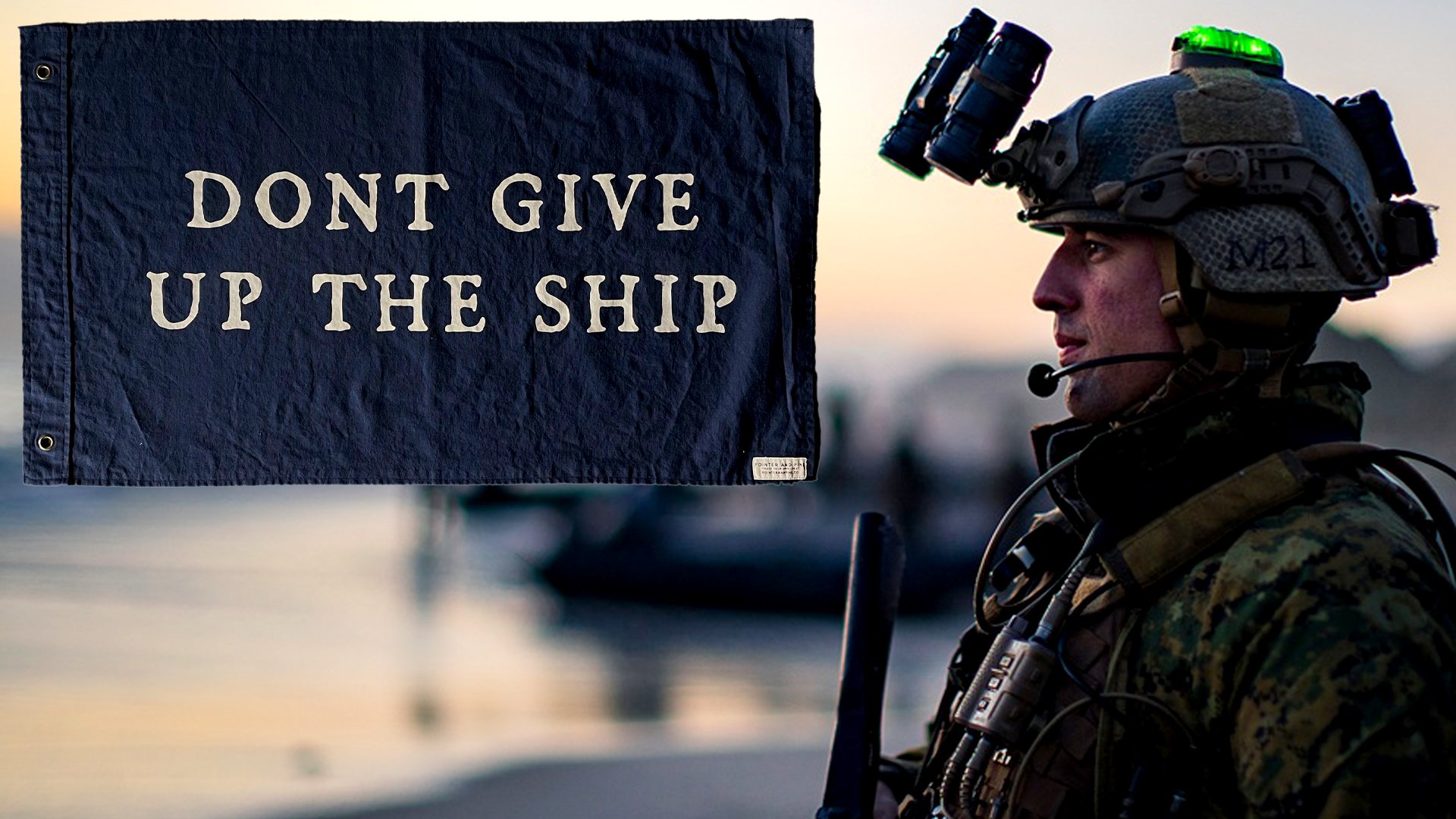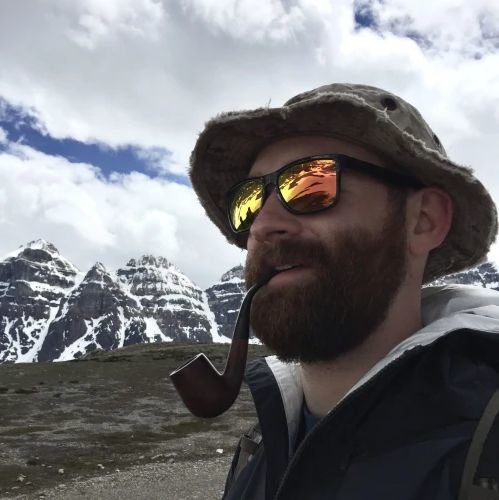Don’t Give Up the Ship: Why the Navy’s Mantra Really Belongs to the Marines

The history behind the Navy's famous rallying cry actually speaks to the bravery of US Marines. Composite by Coffee or Die Magazine.
It took only 10 minutes for the HMS Shannon to defeat the USS Chesapeake during the War of 1812.
With nearly half its crew dead or wounded, its helm destroyed, and its fore-topsail halyard shot away, the Chesapeake — one of the original six frigates of the United States Navy — was dead in the water. Its captain, James Lawrence, lay belowdecks, mortally wounded by a British sharpshooter. Knowing the enemy would soon try to board his crippled vessel, Lawrence uttered a final order, “Don’t give up the ship. Fight her till she sinks.”
Lawrence’s bold command would be forever remembered as the encapsulation of the fighting spirit of American sailors. “Don’t give up the ship” remains an unofficial motto within the Navy, reminding sailors deployed around the globe that they should fight to the last and never surrender. But while many service members might know of Lawrence’s defiant last words, few likely know the real story of what happened after he uttered them, and why that slogan is a more fitting tribute to US Marines than to sailors.

The aircraft carrier USS Theodore Roosevelt flies a replica of Capt. Oliver Hazard Perry’s “Don’t Give Up the Ship” flag, June 3, 2020. Wikimedia Commons photo.
By the time the HMS Shannon was bearing down on the Chesapeake on the evening of June 1, 1813, the United States and Great Britain were already a year into the War of 1812. During that first year of conflict, American and British ships faced off at sea in five major engagements. Each one of those engagements culminated in an American victory. The Royal Navy had underestimated America’s newer, faster fleet of frigates at the start of the war.
So in June 1813, when British Capt. Philip Broke set sail from Nova Scotia in the heavily armed HMS Shannon, he was determined to end America’s winning streak and prove that the Royal Navy still dominated the sea. Capitalizing on America’s overconfidence, Broke sailed the Shannon — a ship he’d already captained for seven years, which sported 38 cannons recently upgraded with new sights — straight for Boston Harbor. He knew the Chesapeake, with its largely inexperienced crew and new captain, would attempt to interdict them.
Citizens of Boston were so confident that the battle would be another American victory that they lined up on the shore to watch the show. But what they witnessed instead was the Shannon destroying the Chesapeake in a matter of minutes.
Lawrence sailed the Chesapeake straight for the British, bringing her parallel with the Shannon. The two frigates exchanged full broadsides. Fire from the British cannons proved overwhelming, immobilizing the Chesapeake and killing much of her crew. In the brief exchange, the Americans suffered 148 casualties, including 61 killed or mortally wounded. Among them were Lawrence, the first and fourth lieutenants, the commander of the ship’s Marines, the master, the boatswain, three midshipmen, and the chaplain. Both of the remaining lieutenants were wounded. As the Chesapeake lay crippled with her crew reeling, Broke led a boarding party to capture the American ship.

Death of Captain Lawrence: “Don’t Give Up the Ship.” June 1813. Copy of engraving by H. B. Hall after Alonzo Chappel, circa 1856. Wikimedia Commons photo.
When British troops began boarding Chesapeake just after six in the evening on June 1, 1813, Lawrence was nearly dead and most of the remaining crew was preparing to surrender. Of the 44 Marines assigned to the Chesapeake, 14 were already dead and 20 more were wounded. Only a single noncommissioned officer and nine junior-enlisted Marines remained able to fight. Remaining faithful to Lawrence’s final command, the Marines attacked the British boarding party while the American sailors stood by and offered no resistance.
In his book The Naval War of 1812, Theodore Roosevelt described the disparity between the actions of the Marines and those of the Chesapeake’s sailors.
“On the upper deck the only men who behaved well were the marines,” Roosevelt, the future US president, wrote. “One of the American marines, using his clubbed musket, killed an Englishman, and so stubborn was the resistance of the little group that for a moment the assailants gave back, having lost several killed and wounded; but immediately afterward they closed in and slew their foes to the last man.”

US Naval Academy midshipmen chant during the Army-Navy game at M&T Bank Stadium in Baltimore, 2016. US Navy photo by Petty Officer 2nd Class Danian C Douglas.
Despite their courageous actions and steadfast adherence to Lawrence’s orders, the 10 fighting Marines were killed, and the Chesapeake was captured by the British. The loss marked the first American naval defeat of the war. Three months later, Capt. Oliver Hazard Perry captained a new American ship, the USS Lawrence, against the Royal Navy during the Battle of Lake Erie. Flying the now-iconic ensign stitched with the words “Don’t Give Up the Ship,” Perry and his comrades defeated the British, seizing all six of their vessels.
It’s been 209 years since Perry’s victory at Lake Erie, and Lawrence’s final command continues to inspire American service members. The very flag that flew atop the USS Lawrence still hangs in Bancroft Hall at the US Naval Academy — where 73 Medal of Honor recipients have earned their commissions — and serves as a daily reminder to midshipmen of the big shoes they have to fill. And although the mantra is a reminder of the Navy’s reputation for courage in the face of great odds, history shows it’s a more fitting tribute to the 10 Marines who actually refused to give up the ship.
Read Next: The Medal of Honor Recipient Who Refused To Die: He Enlisted at 14, Dove on 2 Grenades at 17

Mac Caltrider is a senior staff writer for Coffee or Die Magazine. He served in the US Marine Corps and is a former police officer. Caltrider earned his bachelor’s degree in history and now reads anything he can get his hands on. He is also the creator of Pipes & Pages, a site intended to increase readership among enlisted troops. Caltrider spends most of his time reading, writing, and waging a one-man war against premature hair loss.
BRCC and Bad Moon Print Press team up for an exclusive, limited-edition T-shirt design!
BRCC partners with Team Room Design for an exclusive T-shirt release!
Thirty Seconds Out has partnered with BRCC for an exclusive shirt design invoking the God of Winter.
Lucas O'Hara of Grizzly Forge has teamed up with BRCC for a badass, exclusive Shirt Club T-shirt design featuring his most popular knife and tiomahawk.
Coffee or Die sits down with one of the graphic designers behind Black Rifle Coffee's signature look and vibe.
Biden will award the Medal of Honor to a Vietnam War Army helicopter pilot who risked his life to save a reconnaissance team from almost certain death.
Ever wonder how much Jack Mandaville would f*ck sh*t up if he went back in time? The American Revolution didn't even see him coming.
A nearly 200-year-old West Point time capsule that at first appeared to yield little more than dust contains hidden treasure, the US Military Academy said.












